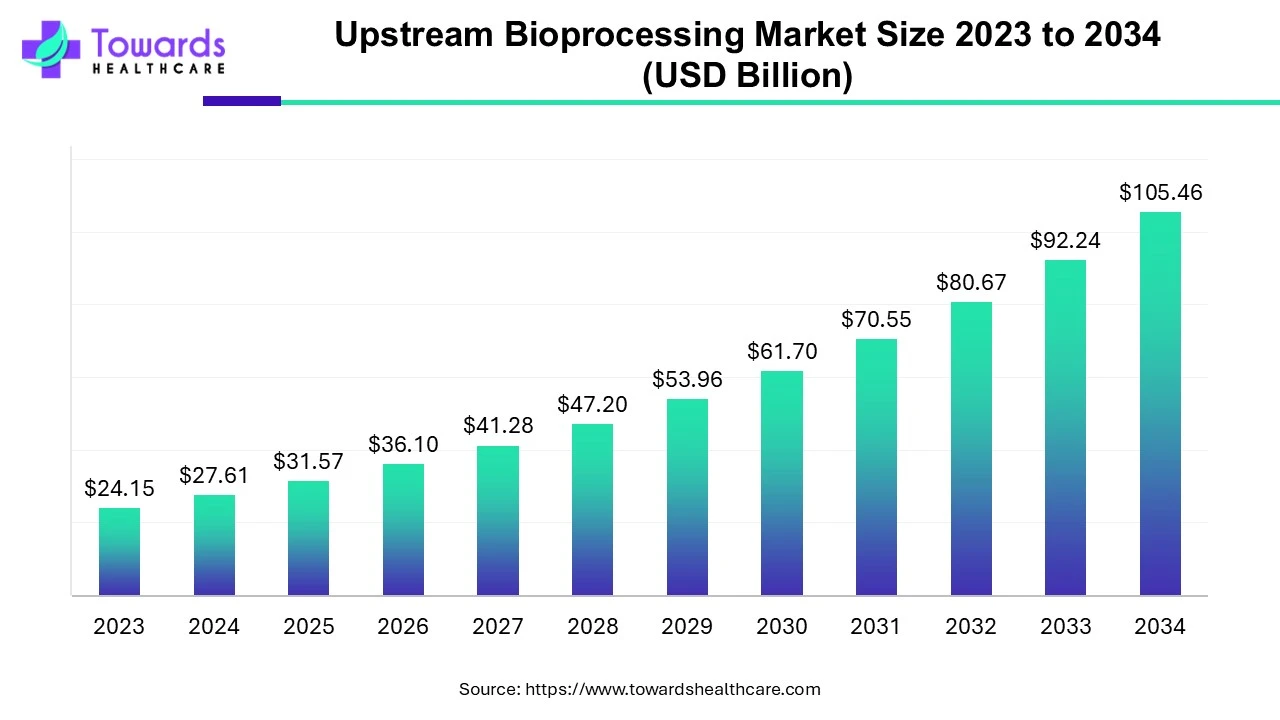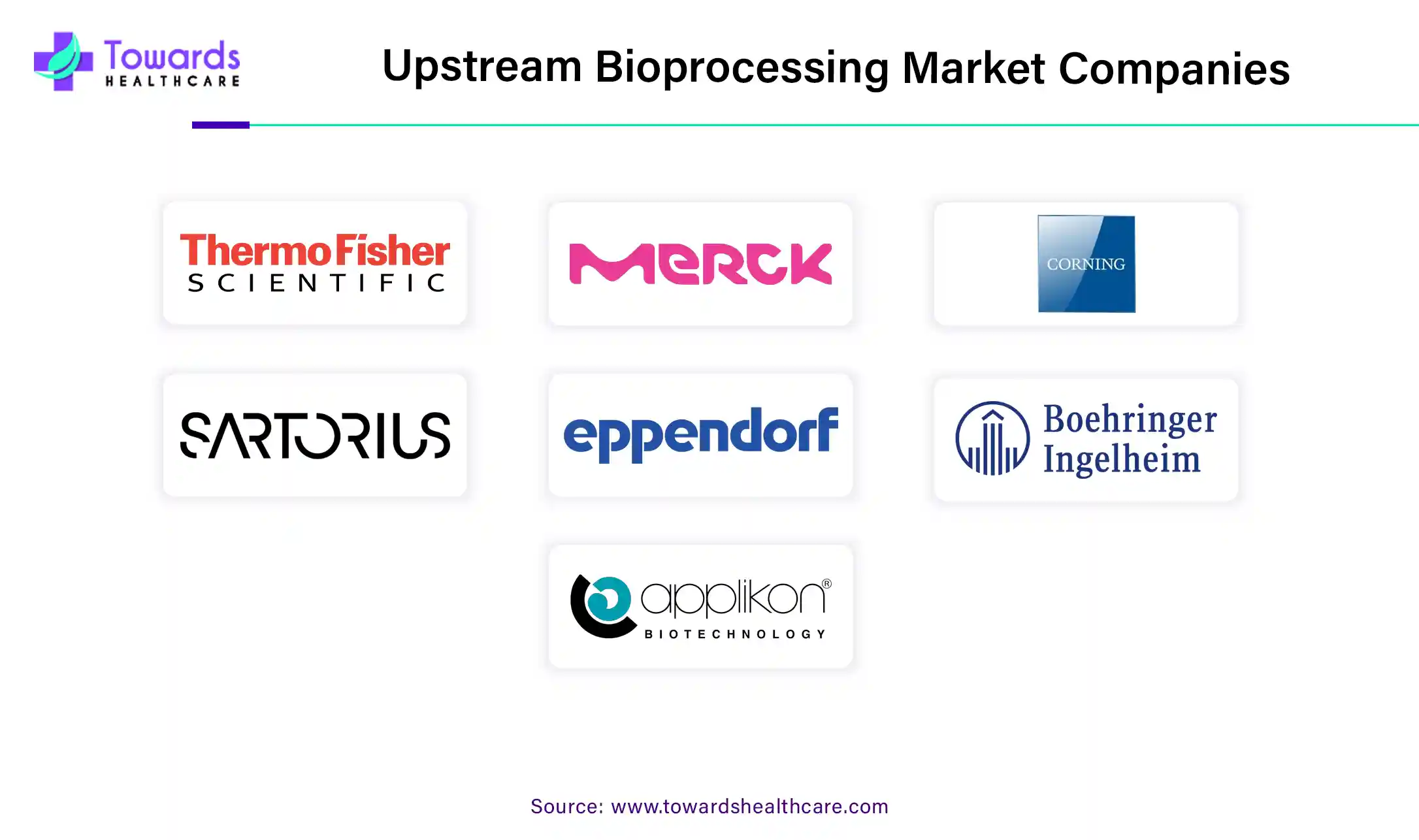April 2025

The global upstream bioprocessing market was evaluated at US$ 24.15 billion in 2023 and is expected to attain around US$ 105.46 billion by 2034, growing at a CAGR of 14.34% from 2024 to 2034. The upstream bioprocessing market is growing as the biopharmaceutical industry uses upstream processing to produce a variety of products including therapeutic proteins, enzymes, antibiotics, vaccines, and biologics. The market needs to develop products and meet the increasing demand for life-saving therapies.

The upstream bioprocessing market is growing rapidly as bioprocessing solutions and services help advance and accelerate research and improve cell culture media and upstream process development plus pilot-scale and manufacturing. However, the main purpose of bioprocessing equipment is to enable cell growth using small numbers of cells from various cell lines. The upstream bioprocess refers to the initial stage of growing bacteria/organisms from bacteria or mammalian cells in bioreactors.
Upstream bioprocessing involves screening and identification of microorganisms, preparation of culture media, and growth of bacteria in bioreactors. Upstream bioprocessing is the first stage of biopharmaceutical production, such as culturing cells or microbial cells to develop proteins. This process involves many steps to achieve the desired result. Biopharmaceutical companies can increase the efficiency of their manufacturing processes, reduce production costs, and produce quality products that comply with international standards.
For instance,
AI integration with upstream bioprocessing is time-saving and cost-effective. From cell culture and optimization to flow processing, bottom-up and upstream processing, the seamless integration of AI and deep learning across the entire bioprocessing value chain will increase the efficiency and power of bioprocessing. It facilitates the integration and analysis of complex data, deciphers “hidden” patterns, and creates predictive models for optimization. Deep learning-based DNN tools are accurate even without large datasets, which is driving the growth of the upstream bioprocessing market.
Increasing Demand for Upstream Bioprocessing from Biopharmaceutical Industry
The upstream bioprocessing market for the biopharmaceutical industry has experienced significant growth due to its significant role in the production of important biological substances such as therapeutic proteins, enzymes, antibiotics, and blocked vaccines. The quality and efficiency of upstream processing directly affect the efficiency, quality, and cost of life-saving products, making it important to meet the global demand for biopharmaceuticals.
As upstream processes lay the foundation for downstream processing, any deviation in factors such as temperature, pH, oxygen levels, and nutrient supply can negatively affect cell or microbial culture health, leading to reduced productivity or contamination. This creates a need for technology and innovation to precisely control growth, which in turn ensures the production of good biological products. As pharmaceutical companies strive to develop effective and safe solutions, the need for reliable, efficient, and safe therapeutic solutions is also driving the growth of the market.
Seed Train Intensification for Enhanced Efficiency
Seed culture intensification brings significant opportunities for the upstream bioprocessing market by streamlining the cell preparation process for bioreactor seeds, ultimately reducing costs, increasing production time, and reducing the risk of infection. By utilizing high-density working cell banks, aliquoted into single-use bags for efficient cryopreservation, this approach ensures that cryopreserved aliquots serve as reliable working cell banks for inoculating intermediate bioreactors in the seed train. This innovative strategy facilitates the rapid scale-up of cell production while maintaining consistent product quality. The integration of advanced technologies, such as the XCell ATF Device, enables the generation of ultra-high-density cell cultures at optimal stages during cell expansion, significantly enhancing manufacturing flexibility, process throughput, and risk mitigation. As companies seek to lower manufacturing costs and improve overall process efficiency, seed train intensification opens new opportunities for growth within the upstream bioprocessing market.
The development of the upstream bioprocessing market is limited by many challenges, especially cell culture and fermentation optimization. Achieving high cell and product yields in bioreactors is important, but not easy due to factors such as cell turnover, limited oxygen exchange, and poor feed quality. Sterility control is also important to prevent contamination and ensure the safety and cleanliness of biopharmaceutical products. In addition, the high cost and long-term use of biopharmaceutical production pose serious problems.
As companies scale from lab-scale to commercial-scale, the challenge of optimizing processes to deliver consistent products and results becomes even more challenging, outright prohibitive. These issues highlight the need for continuous innovation and optimization to reduce costs and increase efficiency in the biopharmaceutical manufacturing process.
North America dominated the upstream bioprocessing market in 2023 as North American scientists are responsible for many research projects on novel biotechnologies, and many scientists in the industry have received training at the National Institutes of Health and other government funding agencies. The second key to business growth and competitive success is the ability to secure needed capital. North America's leadership in the emerging bioeconomy is increasingly critical to America’s global competitiveness, security, and economic growth.
America’s current and future place in the bioeconomy through effective investments in research, technology translation, business research, and training have also offered supplements to the market.
Advances in biotechnology have transformed the world, making possible everything from life-saving vaccines to everyday products like food and biofuels. These innovations have combined the power of engineering with knowledge of nature to advance the American economy. Basic biological research is the engine that drives growth in all areas of the bioeconomy, which has led to the growth of the upstream bioprocessing market.
For Instance,
Asia Pacific is expected to grow over the forecast period to be the largest region in the market as investments in biomanufacturing development and use continue to improve the quality of drugs at lower costs and faster to meet the increasing demand in the Asia Pacific region. The pharmaceutical industry is one of the most important industries mainly due to regulatory and product control and safety, and innovation is often achieved through acquisitions of small companies and start-ups.
The government should encourage businesses in China, South Korea, and Singapore to invest in pharmaceutical research. The government has created many schemes to finance new start-ups and contribute to their significant growth in Asia Pacific. Government leaders and international collaboration also play a significant role in stimulating this momentum, leading to the growth of the upstream bioprocessing market.
The bioreactors/fermenters segment dominated the industry, accounting for the largest market share as bioreactors are the main source of upstream bioprocessing. Cell proliferation occurs in these cells and better products are produced. Bioreactors have different types of operations depending on the biological process being conducted, biomaterials used and products being required. Whereas cell culture products segment is expected to witness the highest CAGR over the forecast period due to the promotion of cell culture media and development of high-end technologies including measurement and manufacturing. From high-quality cell culture products to scalable single-use systems
The cell culture segment accounted for the largest market share as cell culture remains one of the most important bioprocessing tools. Cell culture systems produce higher titers while reducing processing times. Bioprocessor cell culture products enhance the production of monoclonal antibody products, vaccines, and gene/cell therapy modalities. Whereas the media preparation segment is projected to witness the fastest growth rate in the forecast period it involves the creation of media compositions to promote the growth and proliferation of desired cells or microorganisms.
The multi-use systems segment dominated the market with the largest share multi-use systems require a one-time investment, are suitable for larger bioprocess equipment, and can control pH and oxygen, leading to a wide range of applications of these systems. Whereas single-use segment is anticipated to grow at the fastest CAGR over the forecast period due to SUT’s waste streams include bioreactor waste, mixers, tubes, pipes, component connections, standards, filters and cables, and probes/sensors.
The in-house segment dominated the market with the largest revenue share as it involves nutritious culture medium, temperature control, and ensuring that cells have the required quantity and resources to grow and multiply. Whereas the outsourced segment is expected to grow at the highest CAGR over the forecast period due to the increase in outsourcing of bioprocess development can be attributed to various macro and micro level drivers.

By Product
By Workflow
By Use Type
By Mode
By Geography
April 2025
April 2025
April 2025
March 2025